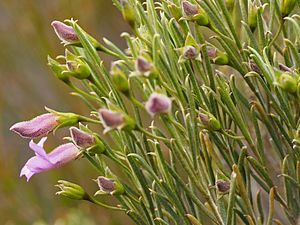Eremophila labrosa facts for kids
Quick facts for kids Eremophila labrosa |
|
|---|---|
 |
|
| Eremophila labrosa growing south of Norseman | |
| Scientific classification | |
| Genus: |
Eremophila (plant)
|
| Species: |
labrosa
|
Eremophila labrosa is a beautiful flowering plant that belongs to the figwort family, called Scrophulariaceae. This plant is special because it is only found in Western Australia, meaning it's endemic to that area. It's a type of shrub with many hairy branches that grow from near the ground. It has narrow, curved leaves and pretty mauve and blue flowers.
Contents
What Eremophila labrosa Looks Like
Eremophila labrosa is an upright, broom-shaped shrub. It usually grows to be about 0.4–1.2 m (1–4 ft) tall. Its branches are covered with tangled, branched hairs. They often feel a bit sticky and look shiny because of a natural resin (like tree sap).
The leaves grow one after another along the branches. They are long and thin, with a curved, hooked tip. Most leaves are about 5–19 mm (0.2–0.7 in) long and 0.8–2.0 mm (0.03–0.08 in) wide. When they are new, they are hairy, but as they get older, they become smooth (which is called glabrous), shiny, sticky, and sometimes rough due to the resin.
The flowers grow one by one where the leaves meet the stem. Each flower sits on a straight stalk that is 5.5–11 mm (0.2–0.4 in) long. There are 5 overlapping, sticky, shiny, and slightly wrinkled sepals (these are like small leaves that protect the flower bud). They are shaped like an ellipse or an egg and are 3.5–6 mm (0.1–0.2 in) long.
The petals are 11–17 mm (0.4–0.7 in) long and are joined together at the bottom to form a tube. The top part of this petal tube is purple, the bottom is pale lilac, and the inside is white. The outside of the petal tube is covered with many glandular hairs (hairs that produce a sticky substance). The inside of the petal tube's tips is mostly smooth. The middle part of the lower lip of the flower is pushed up, almost closing the opening of the petal tube. This part is very woolly inside. The 4 stamens (the parts that produce pollen) are completely hidden inside the petal tube.
This plant flowers from August to October. After flowering, it produces oval or cone-shaped fruits with a pointed end. These fruits are about 5.5–6.7 mm (0.2–0.3 in) long.
How Eremophila labrosa Got Its Name
This plant was officially described for the first time by a scientist named Robert Chinnock in 2007. His description was published in a book called Eremophila and Allied Genera: A Monograph of the Plant Family Myoporaceae.
The second part of its scientific name, labrosa, comes from a Latin word that means "large-lipped." This refers to the very noticeable lower lip of the flower's petal tube.
Where Eremophila labrosa Grows
This type of eremophila plant is commonly found in the areas around Hyden, Grasspatch, and Norseman in Western Australia. It grows in different natural areas known as the Avon Wheatbelt, Coolgardie, and Mallee biogeographic regions.
Conservation Status
The Western Australian Government's Department of Parks and Wildlife has classified Eremophila labrosa as "not threatened." This means that the plant is not currently in danger of disappearing.
Growing Eremophila labrosa in Gardens
This eremophila plant grows upright, narrow, and openly. This makes it a great choice for gardens where you need a plant with this specific shape. It's especially nice because it produces lots of lilac to purple flowers in spring and early summer.
You can grow new plants from cuttings (small pieces of the plant) almost any time of the year. It can grow in most types of soil, even clay, and prefers full sun or partial shade. It can handle dry periods quite well and can also survive heavy frosts.
Images for kids
-
E. labrosa growing south of Norseman


